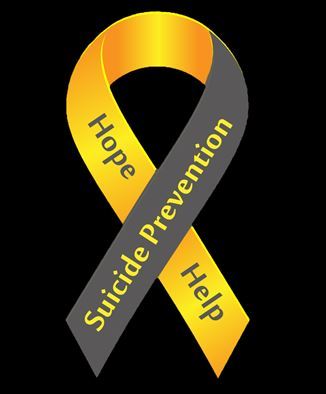
As the 10th leading cause of death in the United States, suicide remains a serious public health problem, according to the Centers for Disease Control (CDC). It is the second leading cause of death among children ages 10–14 and the third among 15- to 24-year-olds. Mental illness, specifically clinical depression, is the most common condition associated with suicide, present in at least 50 percent of all cases, and often undiagnosed and untreated. Those with clinical depression are at a 25 times greater risk of dying by suicide than the rest of the population.
For those who have never struggled with clinical depression nor contemplated suicide, it may be impossible to imagine a place of such unbearable despair that the only solution in sight in the tunnel vision of depression is ending one’s life. Many survivors of suicide attempts eventually come to see that suicide is not the solution—that treatment is available and recovery is possible.

Fighting stigma
Despite the progress we have made, stigma around mental illness continues to linger and is a major contributing factor that prevents some from seeking help. September is National Suicide Prevention Awareness month, a time to share resources, reduce stigma and raise awareness. For several organizations throughout the country, suicide prevention is a daily mission. This is especially true for several individuals who are motivated by their own personal tragedies.
Motivated by pain
Licensed social worker and published poet Stella Padnos has been volunteering for the American Foundation for Suicide Prevention (AFSP) for over 15 years in their suicide survivor outreach program. She and other long-term survivors—persons who have had a loved one die by suicide—visit the homes of recent survivors to offer support and resources. “We offer proof that life can go on after such a devastating loss,” she says. “It is helpful to see and be with people who have been through the same—it is a lot less alienating.” What is most powerful about volunteering, Padnos says, is to see how willing people are to offer something of themselves even when they are filled with so much grief. Padnos became involved with the organization after her fiance took his own life. “He had a history of depression, and years before we met had made previous attempts.”
A history of prior attempts is one predictor of suicide risk. Some other warning signs include withdrawing from family and friends, increased substance abuse, acting recklessly, sleeping too much or too little and talking about suicide or about being a burden to others.
In Padnos’ case, even in hindsight, she says there weren’t glaring warning signs. “A week before he died, he had an appointment with his psychiatrist. He was able to say the right things, and the doctors didn’t pick up on anything either.” In severe cases when someone is really committed to suicide, they’re not going to let on, so there really may be nothing anyone can do. “Guilt is extremely common among survivors,” says Padnos. “Even with the realization that there was nothing they could have done. Time helps, as does realizing that there are a lot of things in the world that are not rational, nor within our control.”
Losing a child to suicide
After losing his 15-year-old son Will to suicide, former Boston Red Sox pitcher John Trautwein and his wife, Susie, created The Will To Live Foundation, a nonprofit foundation, with the mission of spreading awareness of teen suicide and increasing education around the stigma of mental health. For seven years, they have worked tirelessly to get people to talk about mental illness and suicide and to raise awareness in a positive way. To other parents or anyone who suspects their loved one may be at risk, John offers the following advice:
Please—PLEASE—take it seriously—my son Will … took his life. If you believe someone is at risk, - you must act right now. Do not assume “it will be okay.” Will never reached out—he had no signs, thus he never gave us a chance. You have a chance—please take it and get help for your friend immediately. By simply talking about depression like we would talk about cancer, or diabetes, or another more recognizable” illness, we are making it more common—more normal—and therefore more “okay” to talk about. If we talk about it, we can get help.
After losing their son Jordan to suicide, Ernie and Marisa Porco founded the Jordan Porco Foundation (JPF), a nonprofit whose mission is to prevent suicide and promote mental health in young adults. Gillian Anderson works as the Development Director for JPF, whose mission is close to her heart. Three years ago Anderson lost her 15-year-old daughter Abby to suicide. Abby had been diagnosed with clinical depression and was on medication. She had been in therapy until her therapist told her she was okay and could stop coming. “She did seem better,” says Anderson. “Her grades were better, she seemed to be coping. We didn’t talk as much anymore about her mental health because we were relieved! We wanted to believe everything was okay! I just didn’t realize how serious things were in her head.”
Anderson says she now wishes she had asked more questions. “I wish I had asked, ‘Are you feeling suicidal?’ or ‘Do you have a plan? Are you okay? You seem very down, and I want to help and understand what you are going through.’ ... I was doing what I knew to be best at that time.” As a parent of a child who died by suicide, Anderson says, she can “only give advice based on hindsight.”
Always be there for your child. LISTEN and keep the relationship open and honest. Sometimes you need to listen and not try to solve their problems as they can shut down. … There is a delicate line between listening and understanding and not trying to fix everything. Go with your gut instinct if something doesn’t seem right, and get professional help right away. Once you do work with professionals, be the squeaky wheel. Ask a lot of questions. Educate yourself and learn as much as you possibly can! Know that you may be in for a rough ride, but this is your new reality with your child. My best advice is to always tell your child, “I am here for you,” and ask if they are okay. Let them know it’s okay to not be okay! Be aware that they may feel ashamed or guilty of their actions, depression or suicidal thoughts. Understand that they could be in a very dark place and they are trying to climb out.
Anderson and Trautwein hope that parents can learn from their experiences and educate themselves about how to work with their own children. “Suicide does not discriminate,” says Anderson, “and can happen to any family. Take everything very seriously! Let them know they are not alone, and there is hope.”
If you are in crisis, call the toll-free National Suicide Prevention Lifeline at 1-800-273-TALK (8255), available 24 hours a day, 7 days a week. The service is available to anyone. All calls are confidential.
To help promote awareness, go to: https://www.nami.org/Get-Involved/Awareness-Events/Awareness-Resources #SuicidePrevention #StigmaFree
Originally published on Psychology Today